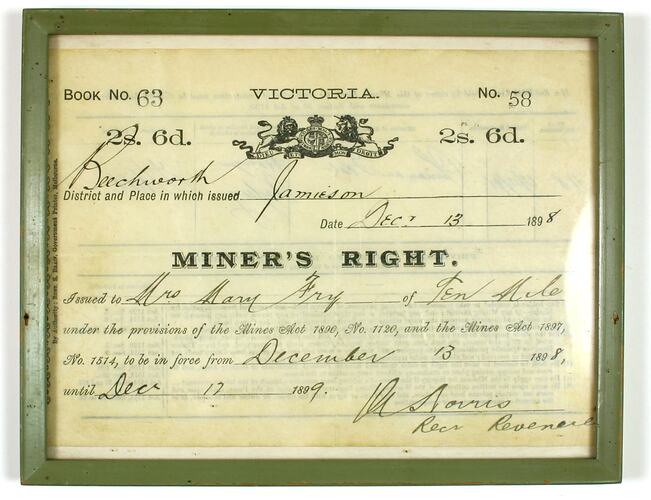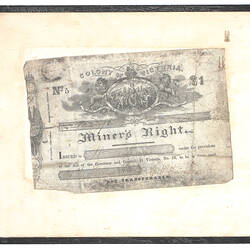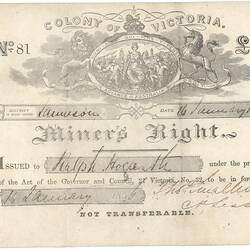Summary
Miner's Right issued at Jamieson, Victoria, to Mrs Mary Fry of Ten Mile under the provisions of the Mines Act 1890, no.1120, and the Mines Act 1897, No.1514, for the period 13 December 1898 to 12 December 1899. The fee paid being 2 shillings 6 pence. Book No.63, No. 58, Beechworth District. Signed by W. Norris, Recr Revenue.
Miners' Rights were introduced under the 1855 Goldfields Act, replacing the Gold Licence that provoked the Eureka uprising in 1854. The Act made a Miner's Right the necessary evidence for the occupation of a mining claim, and from 1857 also gave the holder the right to select a quarter acre of crown land on the goldfields for a residence - a vitally important aspect in the development of Victoria's gold-mining towns. By the end of 1855, 50,000 Miner's Rights had been issued. A fourth Goldfields Act in 1858, gave increased privileges to holders of Miner's Rights including the right to operate a business on crown land (such as a shop or hotel), the right to fell timber on claims and the right to build races and dams on crown lands for mining purposes. Under the Mining Statute of 1865 women not directly engaged in goldmining were permitted to take out a Miner's Right in order to build (or own) a residence or business premises on crown lands in the goldfields.
There is no direct information about the Mary Fry that this Miner's Right was issued to and she is not a person directly connected with the donor's family. There is good circumstantial evidence, however, that she was possibly born in Melbourne, in 1857, under the maiden name of Mary Ann Thompson. In 1876 Mary Ann married 24-year-old George Fry at Yea, and over the following 24 years they had twelve children together: James Henry William (born 1877), Ann Jane (born 1878), Ralph Edward (born 1880), Isabella Emma (born 1882), Albert Henry (born 1884), Robert Moredow (born 1890), Maud Mary (born 1891), an unnamed girl (born 1892, died 1 day old), Alice Lousia (born 1893), Fredrick Samuel (born 1895), Edith Frances (born 1897) and Amy Flor (born 1900, died 1902). The family appears to have lived throughout the 1870s and 1880s at Darlingford, a small mining settlement at the junction of the Goulburn and Big Rivers (now inundated under the waters of Lake Eildon). Later they appear to have moved upstream to Jamieson and then Ten Mile, although several of the later births were recorded at Mansfield, possibly after Mary Ann travelled there for medical treatment during her confinement. Mary Ann Fry died at Mansfield in 1901, at the age of just 43. Her husband died in 1904. Given that her husband was still alive at the time, it is unclear why Mary applied for a Miner's Right herself in 1898.
Ten Mile was a small mining settlement that developed around Tom Allen's Guest House at the Junction of Sailor Bill's Creek and the Goulburn River, 10 miles upstream from Jamieson. Alluvial gold deposits were first opened up on the Goulburn River flats and along Sailor Bill's Creek during 1861, followed by several rich quartz reefs a few years later. Quartz mining became the mainstay of the settlement over following decades, with some of the more notable mines being the Champion, Blue Ribbon, Gleeson's, Sailor Bill's, Clancy's, Hungarian and Alabama. During the 1890s, the settlement had a population of about 200, with 32 dwellings, a hotel, two stores, post office and church. Most of the mines had closed by the 1930s and the last buildings were destroyed in the 1939 bushfires.
Physical Description
Double-sided form printed in black ink on white paper. The item was mounted in a wooden frame with glass cover when received which dates from the mid-20th century.
More Information
-
Collecting Areas
-
Acquisition Information
Donation from Mrs Loris Carter, 01 Oct 2008
-
Issued To
-
Issued By
Victoria: Mines Department, Victoria, Australia, 1898
Issued in Beechworth District. Signed by W. Norris, Recr Revenue. -
Inscriptions
Printed and handwritten text reads: BOOK NO. 63 / VICTORIA NO. 58 / 2s. 6d. 2s 6d. / Beechworth / District and Place in which issued Jamieson / Date Decr 13 1898 / MINER'S RIGHT. / Issued to Mrs Mary Fry of Ten Mile / under the provisions of the Mines Act 1890, No. 1120, and the Mines Act 1897, / No. 1514, to be in force from December 13 1898, / until Dec 17 1899." Signed: "H Norris (iileg.)" (illeg.) "Recr Revenue".
-
Classification
Mining & metallurgy, Exploration & prospecting - alluvial gold, Licences
-
Category
-
Discipline
-
Type of item
-
Overall Dimensions
220 mm (Width), 12 mm (Depth), 174 mm (Height)
Dimensions including frame.
-
References
Ralph W. Birrell, Staking a Claim - Gold and the Development of Victorian Mining Law, Melbourne University Press, 1998. Heritage Victoria, [Link 1] Lloyd, Brian, Gold at the Ten Mile, Shoestring Press, Wangaratta, 1978.
-
Keywords
Alluvial Gold Mining, Economic Geology, Gold, Gold Mining, Goldfields, Licences, Mineral Exploration, Miners' Rights, Mining Regulations, Prospecting



